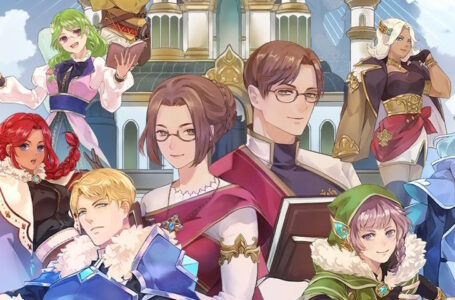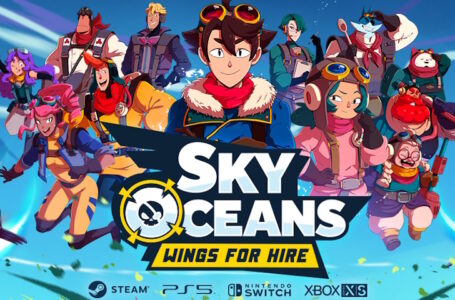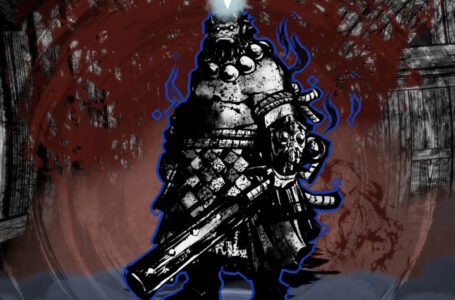Blue Reflection: Second Light – the most emotional RPG gets a stunning sequel
I don’t mind admitting that Blue Reflection: Second Light has been one of my most anticipated games of the year ever since it was first announced back in March. I don’t mind admitting that every new piece of information about Blue Reflection: Second Light made me more excited for the upcoming release — and that our opportunity to preview the opening of the game earlier this year all but convinced me that this was going to be a good ‘un.
And yet somehow, this game has managed to exceed my expectations in almost every way. It builds on everything that made the first game great while simultaneously refining all the slightly weaker aspects of the original — and the result is one of Gust’s finest pieces of work to date. A truly beautiful game that tells a powerful, emotional story — and which does so with satisfying, engaging mechanics that will keep you invested in playing, not just watching cutscenes, for the entire duration.
Full disclosure before we go any further: as I write this, I haven’t yet beaten Blue Reflection: Second Light. It’s a big game with lots to explore — but we also figured that you lovely readers would want to hear about it as soon as we were able to give you some thoughts on it. So what we’re going to do is provide some initial thoughts today, then follow that up with an additional retrospective look back on the whole thing after I’ve had the opportunity to play it through to completion. Sound good? Good, ’cause that’s what’s happening.
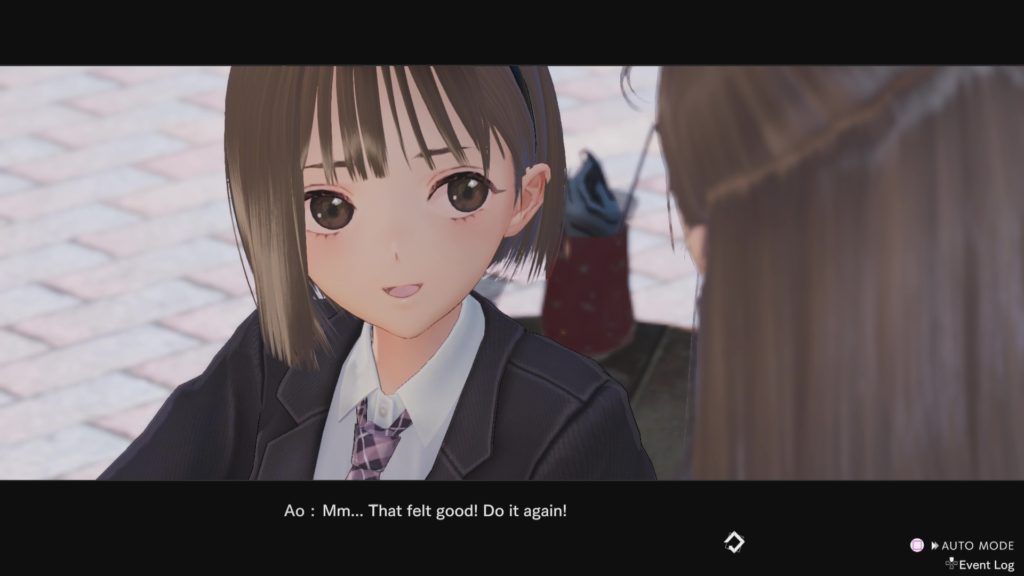
Blue Reflection: Second Light – what’s it all about?
Anyway. To business. Blue Reflection: Second Light casts you in the role of Ao Hoshizaki, a teenage girl who, while heading to summer classes, ended up transported to a mysterious other world. Upon arriving in this peculiar other place, which takes the form of a school on a tiny island in the middle of an apparently endless ocean, Ao discovers that there are four other girls living there — there’s the stern Rena, the childish Yuki, the gentle Kokoro and the mysterious Yuko, the latter of whom doesn’t show her face all that much.
Rena, Yuki and Kokoro have all lost their memories and have no idea what they’re doing in this other world, and no-one seems to know anything about Yuko — not even her real name. Ao, conversely, arrives in the new world with her memories fully intact — and an internal sense of conflict between her desire to get back home and investigate these peculiar circumstances in which she has found herself.
Prior to Ao’s arrival, Rena, Yuki and Kokoro had been keeping themselves making the school in which they are all trapped into something of a habitable location — but shortly after Ao arrives, a strange phenomenon occurs: another land suddenly appears across the water and down some train tracks that lead from the school entrance. Upon approaching this strange land — which they initially dub “The Faraway” — the girls discover that it is an odd, distorted world that appears to have peculiar relevance to Kokoro in particular. Voices echo around the place, and Kokoro begins to feel the stirring of memories thought lost.
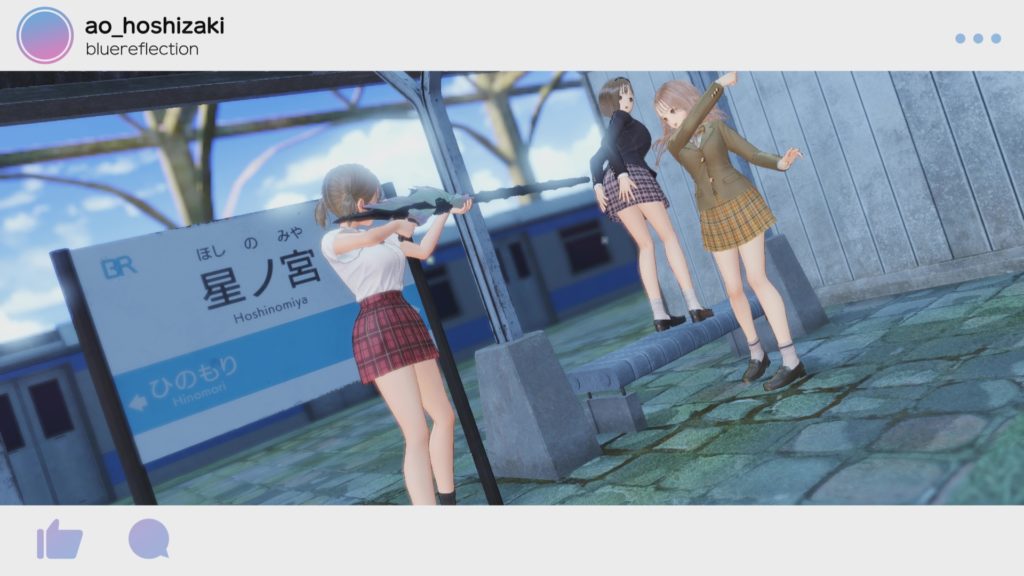
Just to make matters more complicated, all of the girls except Yuki discover that the strange ring on their respective fingers allows them to summon weapons and become Reflectors — magical girls who fight using the power of their emotions. Poor old Yuki isn’t entirely useless, though; her presence provides various passive benefits to the party as a whole.
As you explore the Faraway, you’ll come across memory shards that help piece together important moments in Kokoro’s past life — and eventually, following your exploration through to its natural conclusion will allow Kokoro to recover an emotional Fragment, restoring her sealed memories in the process.
This is essentially the core structure for much of Blue Reflection: Second Light. One of the cast members accidentally stumbles across a “trigger” — usually at Ao’s inadvertent prompting — which causes another world to appear. The cast then explore this new “Heartscape”, as they come to refer to them, during which they uncover some key moments from the girl of the hour’s life, and eventually restore her memories. And, inevitably, what happens next is that someone else gets drawn into the strange other world in which the game is set — usually the person who was most intimately involved with whoever just got their memories back.
This is actually a really interesting narrative structure, because it allows for a distinctly “episodic” feel to the game’s story while still keeping it feeling coherent. The way that each chapter of the main story effectively “chains” on to the next by having a character in common makes for a sense of constant, satisfying discovery as you attempt to track down the truth of the girls’ situation — and it’s a situation that will keep you guessing for quite some time, even if you’re familiar with either the original game or the Blue Reflection Ray spinoff anime series.
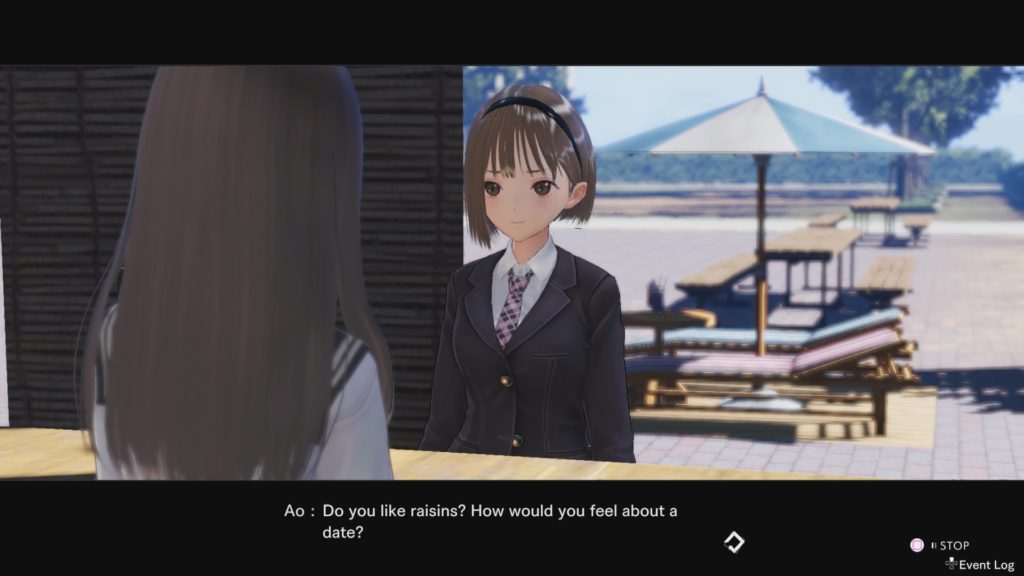
The importance of yuri dates (and more) in Blue Reflection: Second Light
While progressing through Blue Reflection: Second Light’s main story is resolutely linear, there are plenty of things that you can distract yourself with along the way. Most notably are the fact that the various other cast members will often ask Ao for things — either face-to-face or via the in-game Line-like messaging service FreeSpace — and that it’s possible to go on dates with each and every one of them when the time is right. Both of these aspects of the game are actually critical to progression — like you need any convincing to go on a string of shamelessly yuri dates with a bevy of beautiful girls and do absolutely anything and everything they ask of you.
Completing requests for the various characters rewards them with Talent Points, which can be expended on acquiring, you guessed it, Talents. These take the form of both passive and active abilities that make the girls more effective both in and out of combat — combat abilities include increases to basic stats as well as unlocking new skills, while non-combat abilities primarily relate to the game’s crafting system. On top of that, a character’s total overall number of acquired Talent Points — regardless of if they’ve been spent — contributes to their Talent Level, which powers up their own unique innate passive skill.
This side of things is an obvious replacement for the original Blue Reflection’s peculiar levelling system, whereby protagonist Hinako and her two companions Lime and Yuzu did not earn experience points through combat; instead, they immediately gained a level upon completing requests for the various other cast members. This was an interesting system that fit well with the game’s themes of Reflectors gaining power from understanding people’s emotions, but it meant that most combat in the game was more of a mild inconvenience than a mechanical necessity.
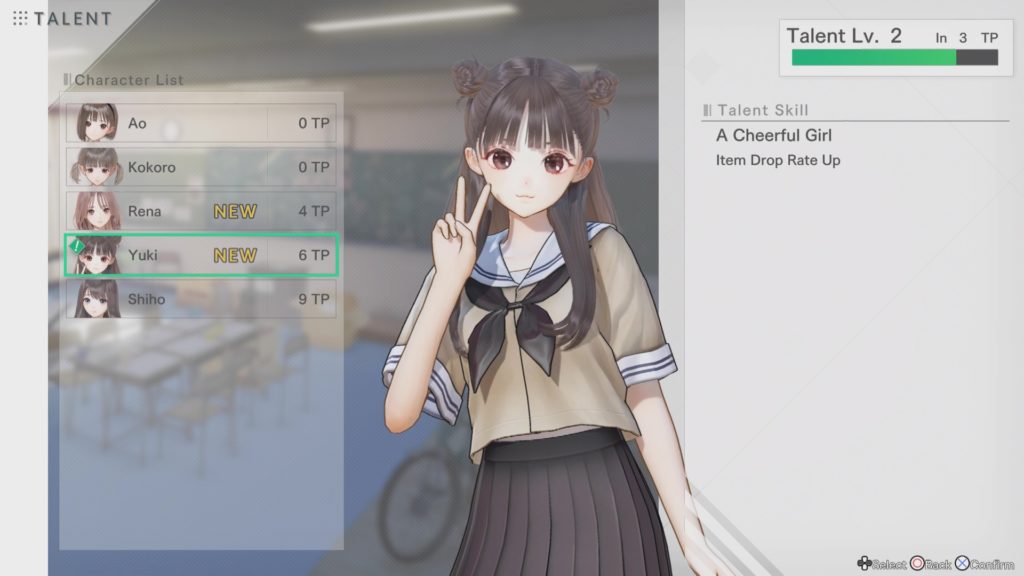
In Blue Reflection: Second Light, meanwhile, you’ll still need to fight in order to gain levels and increase the characters’ basic stats; the Talents, meanwhile, allow you to customise them to a certain extent, as well as gradually unlock more specific abilities. The emotional angle is still there, too; characters’ Talents are split into various categories according to various aspects of their personalities, with more of these categories unlocking as they recover their memories and remember the person they “really” are.
Dates, meanwhile, don’t have a direct impact on character growth in the same way — but they do provide the opportunity for some one-on-one time with a specific character in much the same way that protagonist Hinako could socialise with her classmates in the first game. And, like the socialisation system in the original Blue Reflection, the way in which you have Ao respond to her companions will result in them producing additional Fragments as a result of the encounter — which, in turn, makes up the game’s equipment system.
In Blue Reflection: Second Light, you don’t equip your characters with weapons, armour and accessories. Instead, you equip them with Fragments, and these come in all manner of different types. Some of them provide simple boosts to stats, others provide resistances to status effects or damage types, others still make certain skills more effective — but only under certain circumstances. Understanding how to use your Fragments to effectively complement or make up for your characters’ abilities is important for success in Blue Reflection: Second Light, for sure.
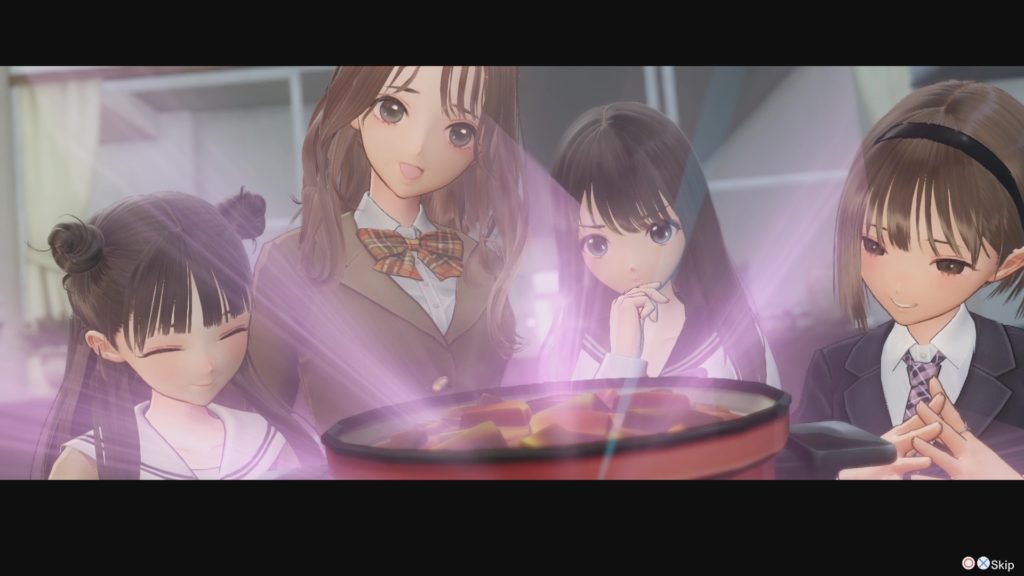
Getting crafty with Blue Reflection: Second Light
All this also ties in with the game’s crafting system, which has two main components. Firstly, you can simply use ingredients you collect around the various regions of the Heartscape in order to make consumable items; this is perhaps most useful for making food that can be used for healing, but it’s also possible to make items that provide temporary buffs to your party and debuffs to the enemy.
Secondly, you can use both raw materials and components you’ve crafted to create new “facilities” around the school. These take the form of various structures that you build around the outside of the school building, and each building typically provides some sort of passive bonus to the girls’ abilities. In some cases, you can also use coins that you occasionally find while gathering to “buy” items of various descriptions, too — the game as a whole lacks a conventional currency and shop system, so this is the only other way to get consumable items besides crafting them.
Crucially, though, the dates with the other cast members all tend to focus on a specific facility, though there are often opportunities for additional conversations on the way to your destination. When spending time with the studious Rena, for example, she’ll often make a beeline for the study desk you’ve set up outside, much to Ao’s chagrin; the cheeky Yuki, meanwhile, enjoys lounging on beach chairs. Without these facilities in the school grounds, those dates won’t happen — and you wouldn’t want to deprive yourself of a hot date now, would you?
The crafting system itself is fairly simple, though there are hints of Gust’s long-running Atelier series present in it, as you might expect.
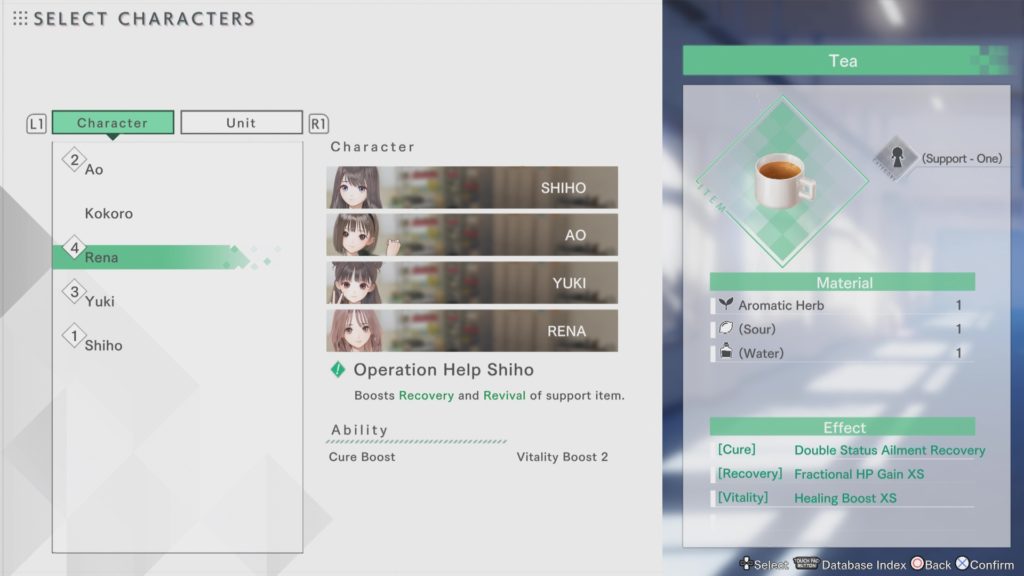
Upon choosing a recipe, you’ll be prompted to choose ingredients, and these either come in the form of a very specific ingredient, or a broad category of ingredients that you’re free to choose items from within. Sometimes specific ingredients carry additional effects that can be passed on to the final item, so it pays to keep an eye on all your available bits and pieces, not just the ones that are most plentiful.
Once you’ve chosen the ingredients for your recipe, you can then choose up to four members of the cast to work on the item. Individual characters have their own “boost” abilities that can draw out additional effects of certain items, and Talents allow them to learn more. On top of that, specific combinations of characters form a team that works well together and boosts the effects of the final item still further. Mercifully, the game remembers any winning team combos that you’ve discovered so you can simply pick them from a list in future — no need to make notes here.
There’s certainly no worrying about quality and traits as there is in Atelier — and certainly no alchemy minigames as in the more recent installments — but there’s enough depth in Blue Reflection: Second Light’s crafting system to make it feel more substantial than a simple “item exchange” process. And, as previously noted, it’s the main way in which you’ll get your hands on consumable items — so you’ll need to engage with it sooner rather than later!
Thematically, this actually works rather well, since it’s meant to represent the fact that although the school the girls are trapped in has modern conveniences such as electricity, wireless Internet and running water, they’re still essentially forced to fend for themselves and survive how they can. While there’s no penalty for not remembering to cook up new food and supplies for the girls on a regular basis, you’ll make your life out in the Heartscape a lot easier if you remember to set off with a well-stocked pack. Everyone loves a sandwich, after all.
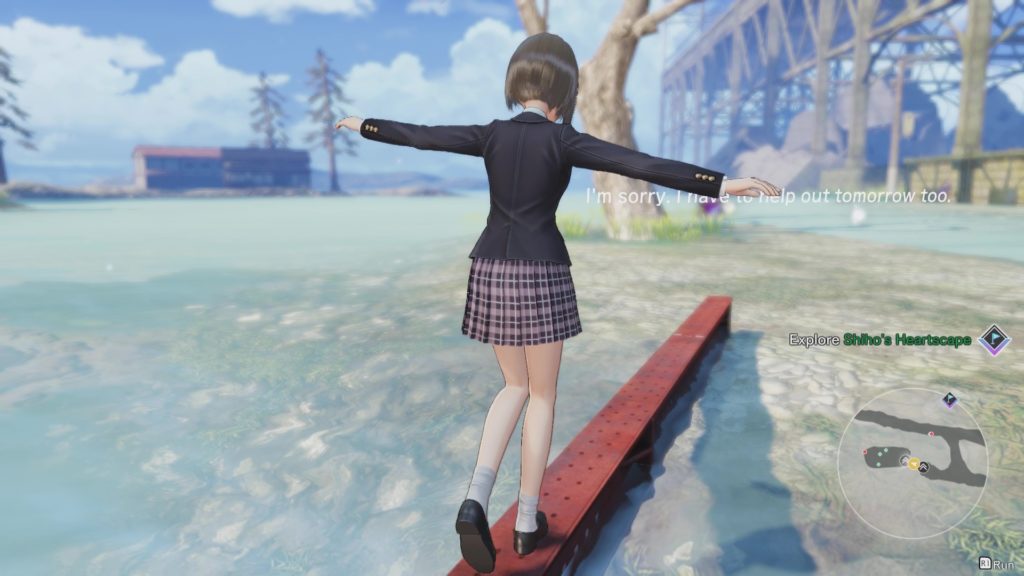
Delving into the truth of the Heartscape in Blue Reflection: Second Light
Once out into the Heartscape, you’ll primarily be exploring and fighting. Each character’s Heartscape consists of several “layers”, each reflecting part of their memories or personality; sometimes the relevance of each is obvious, while at others there’s some deeper symbolism going on that bears thinking about. Pleasingly, the game never batters you over the head with its more symbolic elements when it decides to be a bit more subtle — sometimes the girls will comment on the fact that things they’re seeing may well represent something, but for the majority of the time you’re left to interpret things as you see fit.
As you explore, you’ll come across items that you can gather, represented as glowing crystals, along with “memories”, which add crafting recipes to your repertoire, and the aforementioned memory shards that relate to the current chapter’s “main character”. There are also travel gimmicks to make use of as you get around, including beams to balance on, things to crawl under, ladders to climb and one-way slopes to slide down. None of these things make getting around especially complicated — this certainly isn’t a dungeon crawler — but as the game progresses, the environments get increasingly elaborate and interesting, with optional routes to explore if you want to track down all the memory shards and crafting memories in particular.
You’ll also find certain parts of the map “locked off” until you have an appropriate item to deal with the various barricades in your way; these are clearly marked on the in-game map with a black cloud to show you can’t enter them, and examining the barricade will inform you if you’re at a point in the game where you’re able to craft the required item in question. Conversely, if Ao comments that she doesn’t see a way around the barricade when you check it, you don’t need to waste any time faffing around — just come back again later.
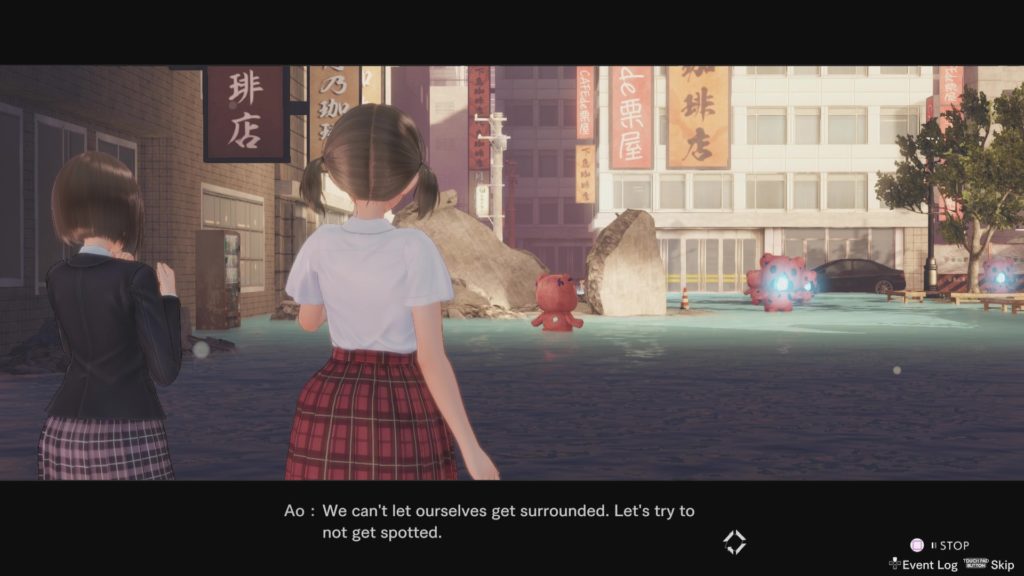
The Heartscape “dungeons” are a big improvement over the original Blue Reflection’s “Common”. While the symbolic aspect of the Common’s various emotionally themed areas — and the ways in which they started to blend together as the game went on — was pretty formidable from an artistic perspective, there wasn’t a lot of incentive to really explore. Maps would simply loop around on themselves, so it would more often be a case of get in, achieve an objective and then get back out again rather than really drinking in the beautiful (and sometimes horrifying) scenery around you.
In Blue Reflection: Second Light, meanwhile, the environments are built with a real sense of purpose. They’re designed to lead you around in various directions, draw your attention to various interesting things and provide you with a feeling that you’re actually exploring, not just proceeding down a linear path. And you’re often rewarded for leaving the beaten track with little extracts from the memory shards’ dialogue being “projected” onto the environment, giving you hints about what is to come before you reveal the next part of the truth more conclusively.
And, of course, those environments are full of enemies. As in most Gust games, Blue Reflection: Second Light makes use of a “symbol attack” system, whereby enemy figures move around the map and pursue you, and hitting them with your weapon before they run into you allows you to start combat with an advantage. There’s an additional layer to this here, though; by switching into “stealth” mode you can view your foes’ vision cones, sneak around behind them and whack them in the back to kick off combat. If you do this, you not only start the battle with an initiative advantage, you also do a little bit of initial damage and make them vulnerable to being knocked down.
The different types of enemies actually behave noticeably differently from one another on the field screen. Some will patrol; some will quickly and furtively look around; others still will sit firmly in place gazing in a single direction until something attracts their attention. Learning the best way to approach different enemies in the field is very helpful in Blue Reflection: Second Light — that initial damage and knockdown bonus can make a big difference.
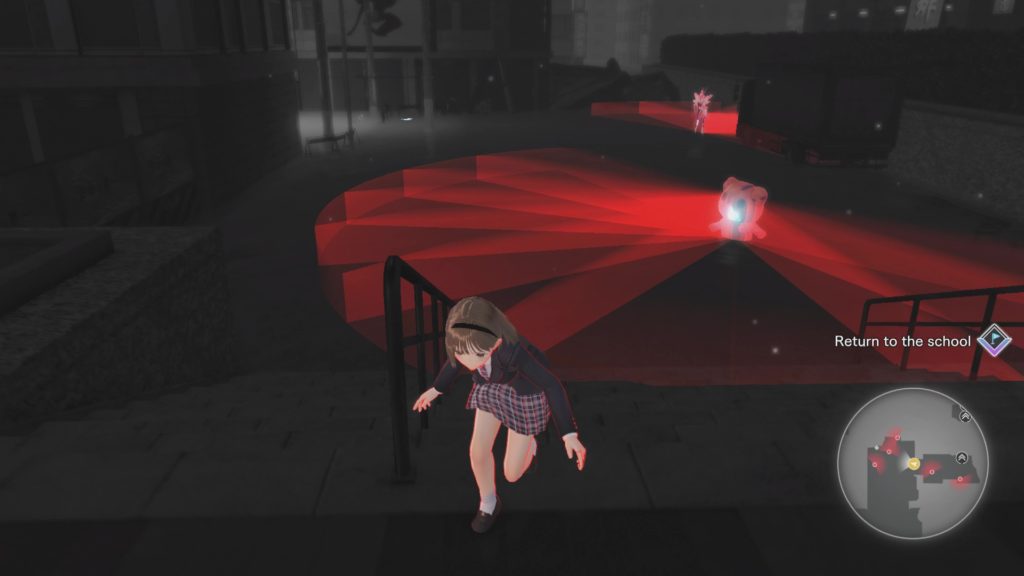
Treading softly and carrying a pointy stick in Blue Reflection: Second Light
And so we come to combat, which is another area that Blue Reflection: Second Light has had a significant upgrade — and this is probably one of the highlights of the experience as a whole.
The original Blue Reflection made use of a system similar to that found in titles such as Game Arts’ Grandia series and Gust’s own Atelier Iris 2: The Azoth of Destiny; both player characters and enemies occupied the same timeline, taking their actions when their icon reached a specific point on it. Certain abilities could knock players or enemies back on the timeline, delaying their turn or interrupting the charging of a powerful attack — but at heart it was still essentially a turn-based system.
In Blue Reflection: Second Light, we have a system that initially seems fundamentally similar, but which adds a significant real-time, simultaneous element to the mix. Here’s how it works.
As your playable characters wait for their turn, they charge their “Ether”, which in turn causes them to move along the timeline. When they reach at least 1,000 Ether, they can take an action — with each action costing at least 1,000 Ether to perform and thus setting them back on the gauge to charge again. At the same time, the enemies are charging their own Ether from the other end of the gauge, and will set off their own abilities when they reach the 1,000 Ether mark.
The twist is that all this happens at the same time, meaning that if several girls are ready to attack at the same time, you can wind ’em up and let ’em fly simultaneously. It also means that it’s possible to interrupt enemy attacks that are about to go off — if you kill an enemy that is just starting its attack animation, you’ll take them out before anyone takes any damage.
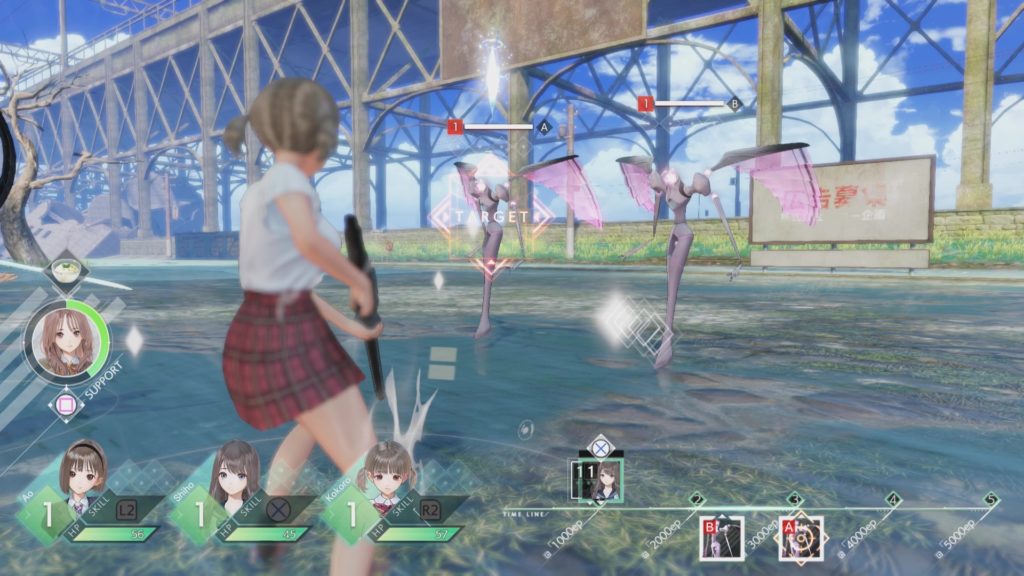
So far, so turn-based. There are a few layers on top of all that which make things really interesting, though. Firstly is the fact that each skill successfully used in combat causes the user’s Ether recovery rate (i.e. the speed with which they move on the timeline) to increase slightly — meaning that the longer combat goes on, the more fast-paced it gets.
Alongside this, at various milestones of Ether recovery rate, the character will “shift gear”, which gives them access to more powerful versions of their existing skills — or in some cases completely new skills altogether. It also allows them to store more Ether, meaning they can either use more skills in succession, or use more powerful skills with a higher cost.
At third gear, the girls transform completely into their Reflector forms, complete with fancy, elaborate and sometimes somewhat provocative outfits to enjoy as part of the process. And on top of all that, some Fragments also only come into effect at a particular gear, too.
There are three girls active in battle at any one time, with a fourth in a “support” position. The support girl is able to use items every time her gauge fills, plus also every few times the gauge fills there’s a set chance (up to 100%) she will use a particular skill to benefit the party — depending on the character, this could be a buff or even full-party healing.
Alongside all this, there’s a combo system, where the more times you hit enemies in succession, the more damage the next skill strike will do. Consequently, your initial hits in combat will barely scratch the enemy, but as the battle progresses, each of the girls will quite happily be cleaving opponents in half with a single hit. It’s a really satisfying means of representing how the pace and intensity of battles increase the longer they go on for.
You have to be a bit careful, though; more powerful enemies have “Danger” attacks that will wipe your combo if they hit, meaning you’ll need to use Ao’s Combo Guard ability with the right timing to ensure that everyone stays safe and you keep your damage-dealing up to the max. This is absolutely critical when dealing with bosses — and that timing window gets increasingly challenging as the game proceeds.
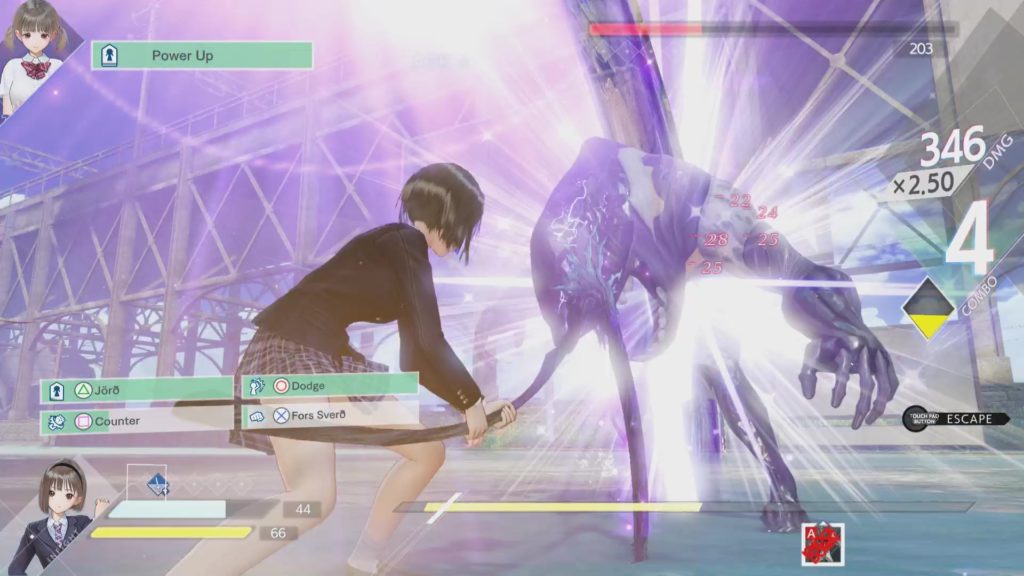
Speaking of bosses, typically knocking an enemy down simply makes them more vulnerable to your attacks for a short period, as well as slowing their progress on the timeline to a crawl. But in the case of more powerful enemies, achieving a “knockdown” actually causes them to put a shield up in front of them while they recover — hitting this enough times to break it causes one of your characters to engage the enemy in a one-on-one “Infight”. This also sometimes occurs when the enemy singles out one of your characters themselves, too, so you need to be ready for it in tough battles!
Here, each button on the controller is simply mapped to a particular move: on PlayStation 4, for example, you press X to attack, square to counter, circle to dodge and triangle to use a buff. Each move has a particular cooldown before it can be used again, with the attack command having the shortest by far, thereby encouraging you to unleash as many hits as possible.
But while you’re doing this, the enemy is proceeding down a gauge at the bottom of the screen; you’ll need to dodge or counter when they reach the mark, lest you lose your combo and take some damage. Dodging has a more generous timing window; countering, meanwhile, allows you to do some damage in return, making it more likely you’ll trigger a powerful “Finisher”.
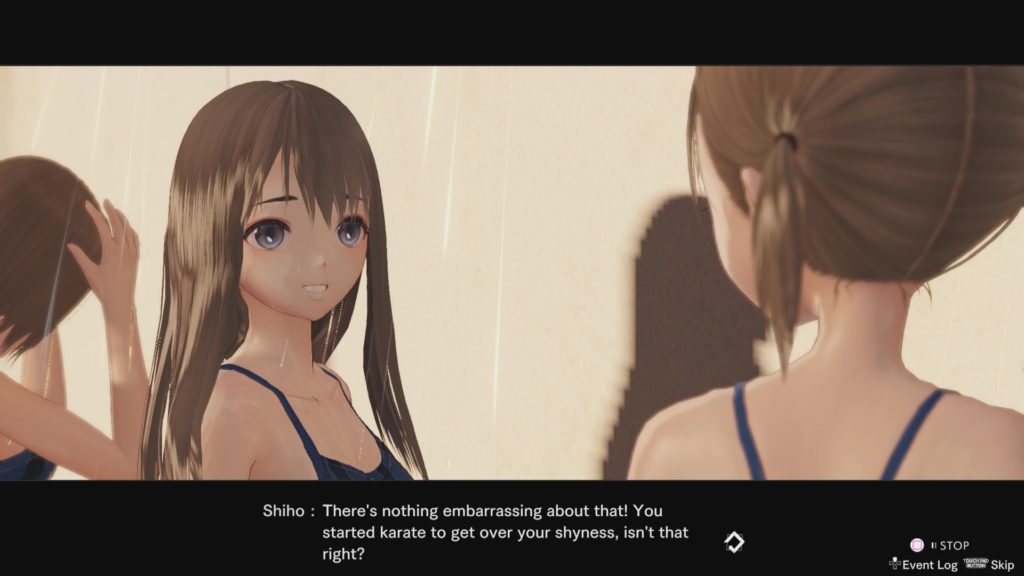
Wrapping things up for this initial look at Blue Reflection: Second Light
Hopefully the preceding several thousand words has convinced you that Blue Reflection: Second Light is very much worth a look, regardless of how well you got on with the first game in the series. This really is a magnificent evolution of what made the first game great while building on the things it could have done better — and the result is a truly, truly excellent, if somewhat unconventional, RPG.
And as if that weren’t enough, it’s beautifully presented, too. The environments are full of wonderful detail and beautifully high-resolution textures that bring a real sense of time and place to the various locales you visit. The character models are full of personality, and really capture the intent of artist Mel Kishida’s original designs. The enemies are imaginative, memorable and, at times, downright disturbing. And the whole thing is held together by a spectacularly good soundtrack, once again blending gentle piano and orchestral pieces with energetic electronica to produce something that will stick with you long after you’ve finished playing.
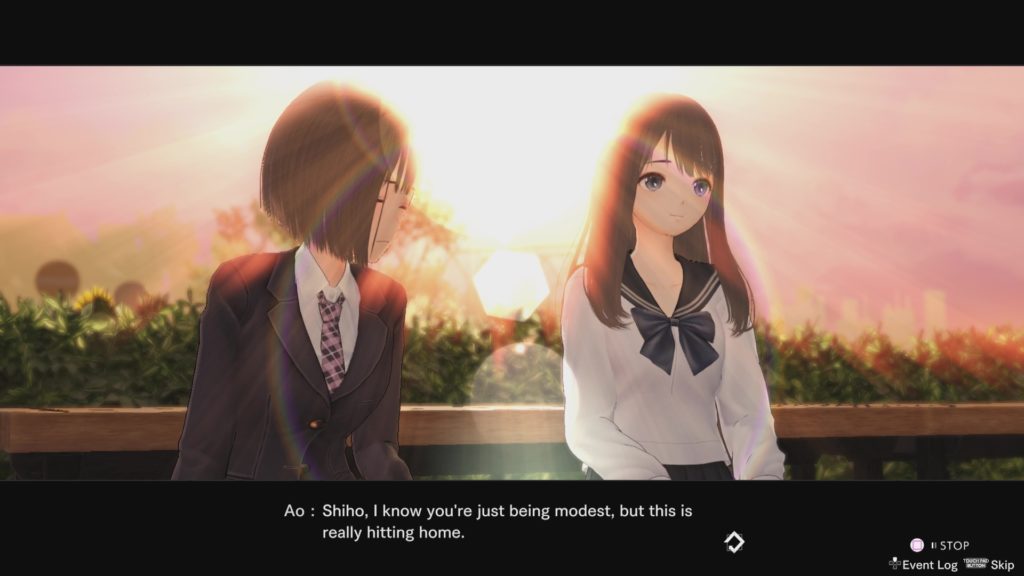
Blue Reflection: Second Light is an absolute triumph. And the sad thing is, if the first game is anything to go by, it’s likely to be all but ignored by a good 90% of the game-playing public and media alike.
Don’t be part of that 90%. Support games like Blue Reflection: Second Light that not only have a clear artistic vision, but also deliver on it in spades. Hold hands with girls. And learn what it’s like to tear up at nothing more than a single measure’s worth of twinkly piano music.
Now I’m off to go keep playing and probably have a good cry. Thank you for your time and attention.
Blue Reflection: Second Light is available now for PC, PlayStation 4 and Nintendo Switch. Thanks to Koei Tecmo for the review code. Screenshots in this article are from the PS4 version.
Join The Discussion
Rice Digital Discord
Rice Digital Twitter
Rice Digital Facebook
Or write us a letter for the Rice Digital Friday Letters Page by clicking here!
Disclosure: Some links in this article may be affiliate links, which means we may earn a small commission if you make a purchase after clicking on them. This is at no additional cost to you and helps support Rice Digital!
- Letter from the Editor: passing the torch - June 30, 2023
- Super Woden GP 2 is looking promising - June 30, 2023
- Inti Creates is making a 32 bit-style Love Live action platformer - June 26, 2023




